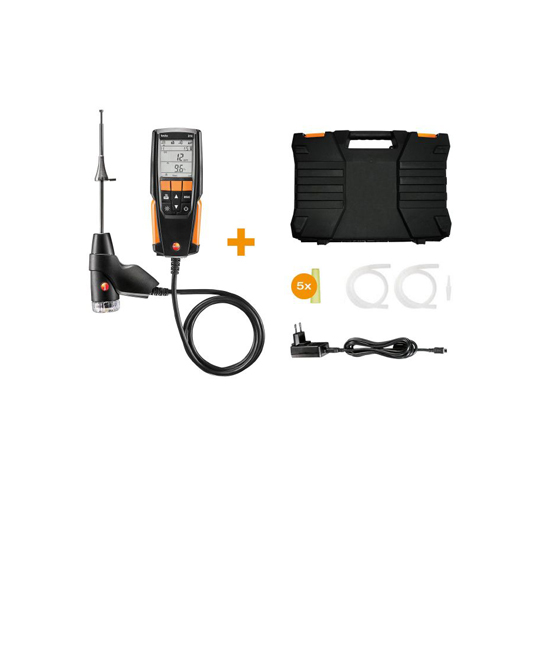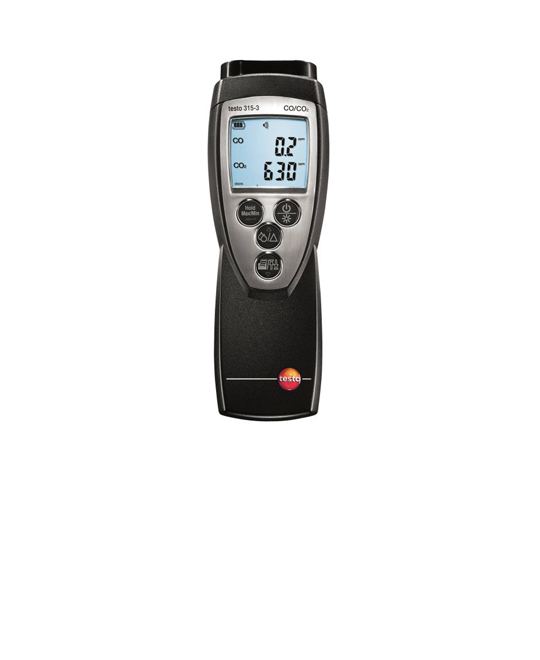Entry-level flue gas analyzer – testo 310
Entry-level flue gas analyzer – testo 310 with Accurate readings, rugged design, easy-to-use That’s what you as a professional want from a measurement tool so that you can carry out quick and reliable checks on heating systems.
The testo 310 entry-level flue gas analyzer. For reliable heating system checks
The testo 310 has an easy-to-use menu guide four integrated menus for flue gas, draft, CO ambient air and pressure measurements, a large, easy-to-read display and a backlight for use in all lighting conditions.
But that is by no means all. The compact flue gas analyzer has a wide range of useful features that make it the ideal companion for plumbing and heating fitters.
- Thanks to the built-in magnet, it can stick to almost any metal object, like a burner for example, leaving both hands free for other tasks.
- The sensor can be zeroed in as little as 30 seconds
- The sensor filter is just as easy to replace.
- In addition to that, the device has a rugged design which protects it against impact and damage
- and an easy-to-empty condensate collection tank.
- To round things off, the readings can also be transferred directly to your testo turbo printer (optional) via the analyzer’s infrared interface, allowing you to print out on site.
Temperature - TC Type K (NiCr-Ni) |
|
|---|---|
| Measuring range | -20 to +100 °C |
| Accuracy | ±1 °C |
| Resolution | 0.1 °C |
| Reaction time | <50 s |
Temperature (ambient temperature)
Temperature - TC Type J (Fe-CuNi) |
|
|---|---|
| Measuring range | 0 to +400 °C |
| Accuracy | ±1 °C (0 to +100 °C)
±1.5 % of mv (>100 °C) |
| Resolution | 0.1 °C |
| Reaction time | <50 s |
Temperature (flue gas)
Flue gas O₂ |
|
|---|---|
| Measuring range | 0 to 21 Vol.% |
| Accuracy | ±0.2 Vol.% |
| Resolution | 0.1 Vol.% |
| Reaction time t₉₀ | 30 s |
Differential Pressure flue gas Draught - Piezoresistive |
|
|---|---|
| Measuring range | -20 to +20 hPa |
| Accuracy | ±0.03 hPa (-3.00 to +3.00 hPa)
±1.5 % of mv (Remaining Range) |
| Resolution | 0.01 hPa |
Flue gas degree of effectivity, Eta (calculated) |
|
|---|---|
| Measuring range | 0 to 120 % |
| Resolution | 0,1% |
Flue gas loss (calculated) |
|
|---|---|
| Measuring range | 0 to 99.9 % |
| Resolution | 0,1% |
Flue gas CO₂ calculation (calculated from O₂) |
|
|---|---|
| Measuring range | 0 to CO₂ max (Display range) |
| Accuracy | ±0.2 Vol.% |
| Resolution | 0.1 Vol.% |
| Reaction time t₉₀ | <40 s |
Pressure measurement |
|
|---|---|
| Measuring range | -40 to +40 hPa |
| Accuracy | ±0.5 hPa |
| Resolution | 0.1 hPa |
Flue gas CO (without H₂-compensation) |
|
|---|---|
| Measuring range | 0 to 4000 ppm |
| Accuracy |
±20 ppm (0 to 400 ppm) ±5 % of mv (401 to 2000 ppm) ±10 % of mv (2001 to 4000 ppm) |
| Resolution | 1 ppm |
| Reaction time t₉₀ | 60 s |
Ambient CO |
|
|---|---|
| Measuring range | 0 to 4000 ppm |
| Accuracy | ±20 ppm (0 to 400 ppm)
±5 % of mv (401 to 2000 ppm) ±10 % of mv (2001 to 4000 ppm) |
| Resolution | 1 ppm |
| Reaction time | 60 s |
General technical data |
|
|---|---|
| Weight | (with probe) Approx. 700 g |
| Dimensions | 201 x 83 x 44 mm |
| Operating temperature | -5 to +45 °C |
| Display type | LCD (Liquid Crystal Display) |
| Display function | Backlit 2-line display |
| Power supply | Battery: 1500 mAh, mains unit 5V/1A |
| Storage temperature | -20 to +50 °C |
Draught measurement in the flue gas duct
Draught measurement is actually a differential pressure measurement. This differential pressure occurs between two sub-areas as a result of a difference in temperature. This is turn generates a flow to compensate. In the case of flue gas systems, the difference in pressure is an indicator of the “chimney flue draught”. This is measured between the flue gas and ambient air at the measurement orifice at the core of the flue gas flow.
Ambient CO measurement in the heated environment
Carbon monoxide (CO) is a colourless, odourless and taste-free gas, but also poisonous. It is produced during the incomplete combustion of substances containing carbon (oil, gas, and solid fuels, etc.). If CO manages to get into the bloodstream through the lungs, it combines with haemoglobin thus preventing oxygen from being transported in the blood; This is why it is necessary to regularly check CO emissions at the combustion points of heating systems, and places often frequented by people (in our case, where the combustion systems for hot water generation are), and in the surrounding areas.
Measuring the flue gas parameters of the burner (CO, O2, and temperature, etc.)
The flue gas measurement for a heating system helps to establish the pollutants released with the flue gas (e.g. carbon monoxide CO) and the heating energy lost with the warm flue gas. In some countries, flue gas measurement is a legal requirement. In some countries, flue gas measurement is a legal requirement. It primarily has two objectives:
1. Ensuring the atmosphere is contaminated as little as possible by pollutants;
2. energy is used as efficiently as possible.
Measuring pressure on burners (nozzle pressure, gas flow pressure, etc.)
Standard readings taken during services of domestic heating systems include checking the gas pressure on the burners. This involves measuring the gas flow pressure and gas resting pressure. The flow pressure, also called supplied pressure, refers to the gas pressure of the flowing gas and resting pressure of the static gas. If the flow pressure for gas boilers is slightly outside the 18 to 25 mbar range, adjustments must not be made and the boiler must not be put into operation. If put into operation nonetheless, the burner will not be able to function properly, and explosions will occur when setting the flame and ultimately malfunctions; the burner will therefore fail and the heating system will shut down.






